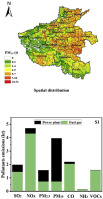当前位置:
X-MOL 学术
›
Atmos. Environ.
›
论文详情
Our official English website, www.x-mol.net, welcomes your feedback! (Note: you will need to create a separate account there.)
County-level emission inventory for rural residential combustion and emission reduction potential by technology optimization: A case study of Henan, China
Atmospheric Environment ( IF 5 ) Pub Date : 2020-05-01 , DOI: 10.1016/j.atmosenv.2020.117436 Mingyue Zhu , Lei Liu , Shasha Yin , Jingwang Zhang , Ke Wang , Ruiqin Zhang
Atmospheric Environment ( IF 5 ) Pub Date : 2020-05-01 , DOI: 10.1016/j.atmosenv.2020.117436 Mingyue Zhu , Lei Liu , Shasha Yin , Jingwang Zhang , Ke Wang , Ruiqin Zhang

|
Abstract In recent years, air pollution has been a serious problem in China, not only in the city but also in the countryside. Moreover, the statistics data of coal and solid biomass consumption for rural households are significantly underestimated, which has a negative impact on the air pollution control. In this study, Henan province, an agricultural province in China, is taken as a case to analyze the county-level emission characteristics and emission reduction potential of rural household combustion. Firstly, activity data at county-level are obtained through regression based on partial activity data from field survey in 2016, and a high-resolution emission inventory of multi-type air pollutants from rural residential combustion is established. Then, twelve abatement technologies are selected to replace coal and solid biomass used in heating and cooking. A new optimization model is established based on the rural household burden ratio to discuss the optimal emission reduction schemes at county-level under five substitution scenarios. The results show that the total emissions of SO2, NOx, PM2.5, PM10, CO, NH3 and VOCs from rural residential combustion in Henan province are estimated at about 108.6, 30.9, 72.7, 113.5, 1141.9, 19.6 and 110.0 kt, respectively. The inventory results of different counties vary greatly, with PM2.5 emissions ranging from 7.9 t to 1550.3 t. Counties with large emissions have more agricultural activities. Among the abatement technologies, air source heat pump (ASHP) and palisade structure (PS) are more suitable for promotion in rural areas. The PM2.5 emissions in the five substitution scenarios are 99.0%, 98.8%, 99.1%, 98.6% and 98.8% lower than BAU-scenario, and S1-scenario is more conducive to rural emission reduction with considering the costs. It is suggested that the government should pay more attention to the air pollution caused by rural household combustion and improve the existing energy statistics system, especially for solid biomass. Abatement technologies suitable for heating and cooking in rural areas should be actively promoted, such as air source heat pump.
更新日期:2020-05-01


























 京公网安备 11010802027423号
京公网安备 11010802027423号